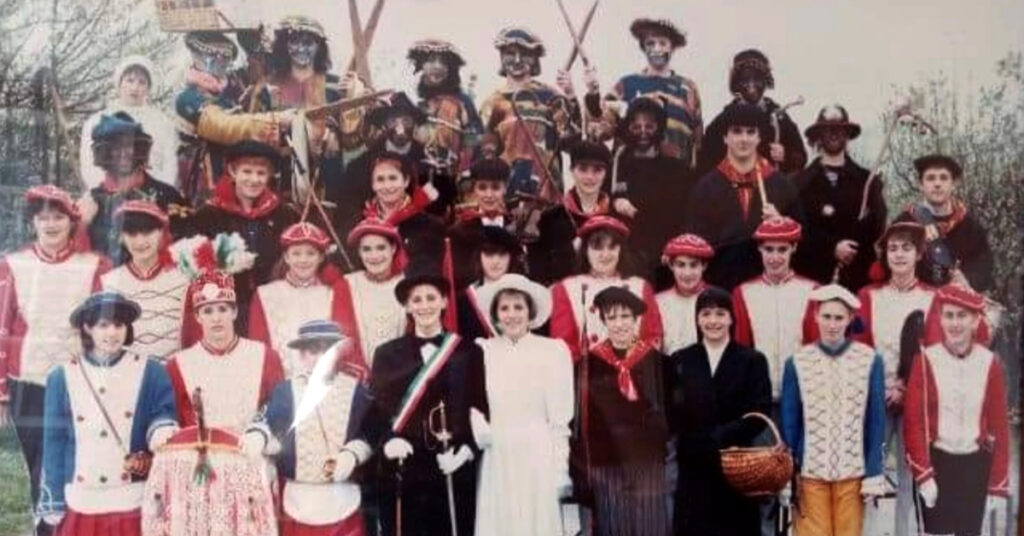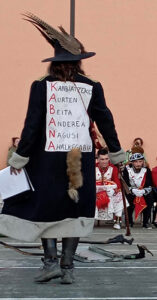Basque ethnography at a glance
Masquerades are the traditional carnivals of the Soule region or Zuberoa as it is known in Basque. Society is divided into two groups in the masquerades. On the one hand, the reds, who represent the good, honourable and formal society. They include the five main characters: the lord and the lady, the peasant man and woman, and the marshals. On the other hand, there are the unscrupulous, unkempt and dirty blacks. That group includes the gypsies, who have been settled in Zuberoa since time immemorial, even though society would continue to harbour prejudices for ages. There are also the characters depicting trades of old: swords sharpeners, horse gelders, or the boilermakers who repaired leaky boilers. In addition to reflecting society, the masquerade aims to be satirical and criticise it.
Throughout the year, young people from one or more villages meet up to prepare the masquerade that they perform from January to April. They go around the villages and towns of Zuberoa every weekend. They get underway in the morning by breaking through the barricades (usually a symbolic obstacle of a bottle of wine and glasses) and dancing through the streets. In the afternoon, the players put on their performance in the town or village square. In 2024, it was the turn of Pagolle. Indeed, after performing the pastoral – the traditional play of the Zuberoa region – in 2019, the local young people decided to prepare the masquerades. It should be noted that Pagolle’s participation is unusual, given its special relationship with Zuberoa. In fact, geographically speaking, Pagolle is not fully within Zuberoa. One of the sides of the river is in Zuberoa and the other in Lower Navarre. Its residents speak a dialect that is half bajonavarro, half zuberotarra, known as Amikuze Basqye. This would explain why Pagolle’s culture differs from that of Zuberoa. Yet that has not prevented them from showing everyone that Pagolle embraces Zuberoa’s culture.
The Pagolle masquerade does not feature some of the usual characters, such as the gypsies, the sword sharpeners or Pitxu. However, one of them has rocked the Zuberoa tradition, as a woman now appears as Kabanasa, one of the most important characters. Pitxu and Kabana have traditionally been men’s roles, which explains a woman being cast to play Kabana for the first time being noteworthy. Women participating in the masquerades and, in general, from a cultural perspective in Zuberoa is relatively recent. It can be traced back to the 1940s. In 1944, three women from Barkoxe achieved the right to dance officially and in public. In 1946, six women took part for the first time in the masquerades organised by that town. That was considered a scandal in Zuberoa and women would not be appear in the Urdiñarbe masquerades until 1977.
Women have gradually been included in all the roles: dancers, sword sharpeners, gypsies, gelders and boilermakers. 1992 was a special year in Zuberoa, as a masquerade only made up of women was organised for the first time (and the last so far). The young women of Eskiula performed their masquerade around all the towns and villages of Zuberoa, and that was not without criticism. Only Pitxu has since been played by a woman (Joana Hoquy) in 2012 in the masquerade organised by XIO (the Zuberoa Alumni Association). And, for the second time in 2024, a woman, Ainara Aguerre, is playing the character of Kabana.
It has taken several decades for women to be part of the masquerades: from those six first women in 1946 to the women masquerade players of today, where women are practically on a par with men. There are more young women among the dancers, for example, and it does not seem that the trend is going to change. Women are now fully part of Zuberoa and Basque culture and their role should go from strength to strength in the coming years.
Compared to the pastoral play, women have participated for a long time, even though they have only come to the fore in the role of the errejent (director of the pastoral play) very recently; three women have played that role in two pastoral plays running in the last three years. One of them, Xantiana Etxebeste, will direct Luis Luis, the Gamere-Zihiga pastoral play, in 2024.
Iker Uthurralt



